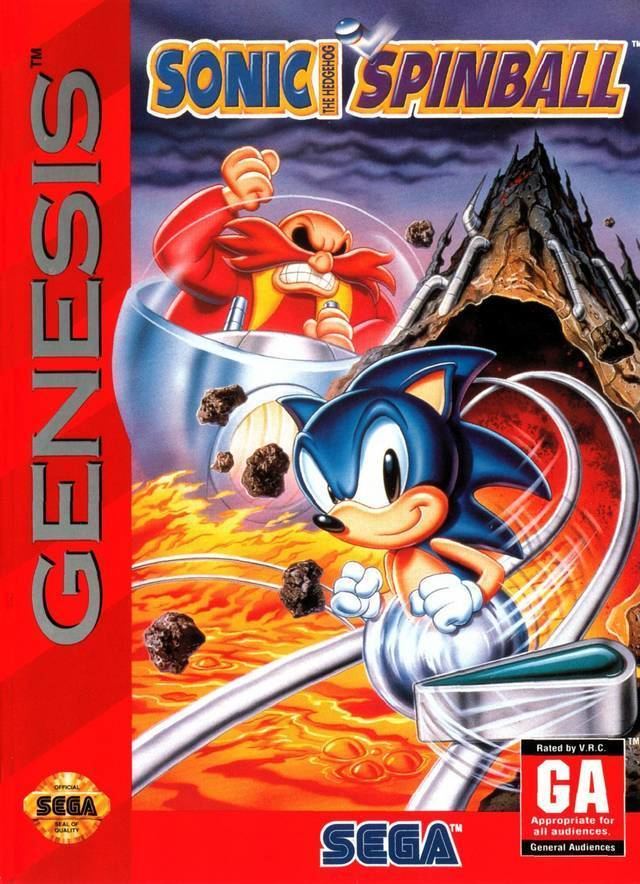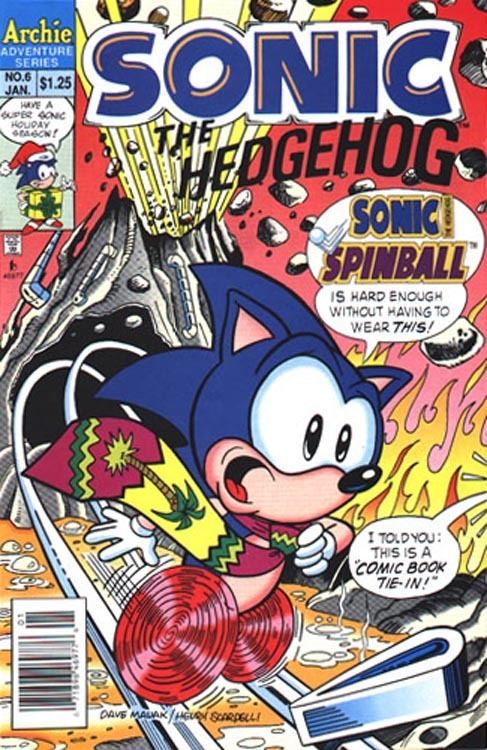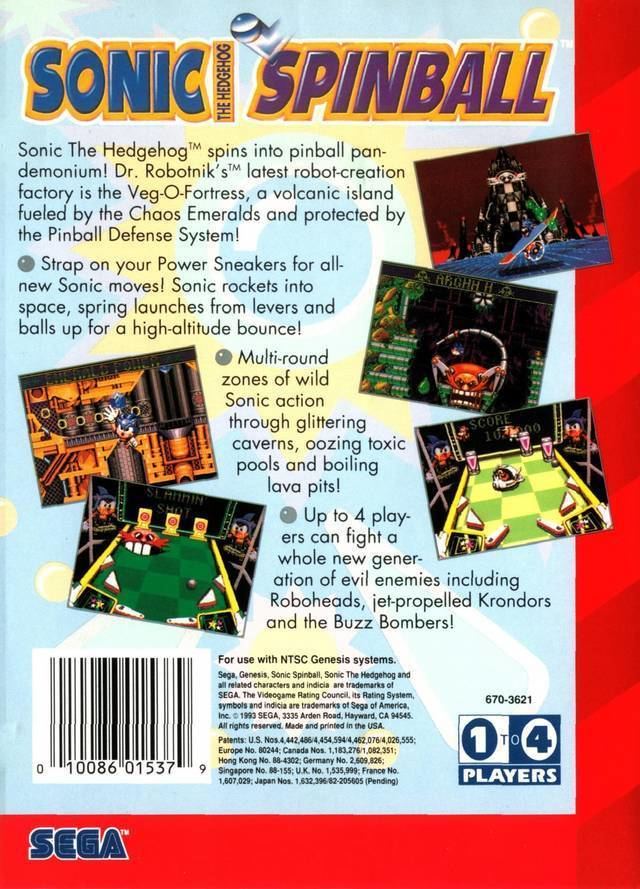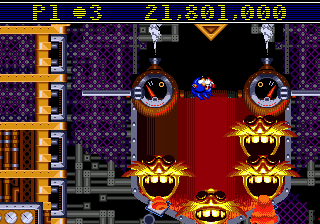8.2 /10 1 Votes
4.4/5 Let's Play SEGA Producer(s) Yutaka Sugano Artist(s) John Duggan Series Sonic the Hedgehog | 4.8/5 Emuparadise 6.1/10 GameSpot Designer(s) Peter Morawiec
Hoyt Ng Initial release date 15 November 1993 Genres Action game, Pinball | |||||||||||||||||||||||||||||||||
 | ||||||||||||||||||||||||||||||||||
Composer(s) Howard Drossin
Brian Coburn
Barry Blum Mode(s) Single-player, multiplayer Platforms Sega Genesis, Master System, Game Gear, Wii, GameCube, Microsoft Windows, iOS Developers Sega Technical Institute, Sonic Team Publishers Sega, Sony Interactive Entertainment, Tectoy Similar Sonic the Hedgehog games, Sonic Team games, Pinball games | ||||||||||||||||||||||||||||||||||
Sonic the Hedgehog Spinball (known as Sonic Spinball in Japan) is a pinball video game developed by the Sega Technical Institute and published by Sega. It was originally released for the Mega Drive/Genesis in North America and Europe in November 1993 and in Japan the following month. It was later ported to the Game Gear and Master System in 1994 and 1995 respectively. The game has been re-released on a total of eleven different consoles since, with many of them being Genesis-related compilations. The game's plot revolves around series antagonist Doctor Robotnik's desire to enslave the population of planet Mobius via a machine powered by pinball-like mechanisms. Unlike most other Sonic games, it is set in the universe of the Saturday morning Sonic the Hedgehog cartoon.
Contents

The game is set in a series of pinball-like environments in which the player controls Sonic the Hedgehog, who acts as a pinball for the majority of the game. Sonic the Hedgehog Spinball was commissioned by Sega when it became clear that a new Sonic the Hedgehog game could not be completed in time for the 1993 holiday season, as the majority of staff were occupied with developing Sonic the Hedgehog 3. The game was hastily designed amid extreme time constraints and was developed in a total of 61 days. It received mixed reviews upon release, with most critics praising the game's novelty and graphics, although its control scheme was considered a negative factor. A second pinball game, Sonic Pinball Party, was released in 2003, and a spinning rollercoaster of the same name opened in Alton Towers theme park in 2010.

Gameplay

Sonic the Hedgehog Spinball is a pinball game in which the player controls Sonic the Hedgehog, who acts as a pinball. The majority of the game takes place within the "Pinball Defense System", which resembles a series of large pinball machines. The game is split up into four levels each containing numerous sets of flippers that can be used to aim Sonic's trajectory and launch him upward through the level. While Sonic can be maneuvered while airborne with input from the directional pad, which can be used for better positioning following an impact with a bumper or target or when Sonic is descending toward the drain, bumpers or flippers.

The goal of each level is to collect all of the Chaos Emeralds that serve to stabilize the volcano and subsequently defeat the newly-accessible boss located at the top of the level. Some Chaos Emeralds are blocked off by obstacles that require Sonic to hit certain switches or bumpers in order to create a clear path to the Chaos Emerald. The boss at the top of each level requires a specific strategy to defeat. A "status strip" at the top of the screen provides hints for defeating bosses as well as encouraging messages when the player makes progress. The "status strip" also tells the player how many Chaos Emeralds are left to collect in a level. Following the defeat of a boss enemy, a bonus round is initiated. These bonus rounds are depicted as regular pinball machines with Sonic at the controls. The player is given three balls to shoot around the board with the purpose of accumulating points by hitting as many bumpers and targets as possible. At any point in the bonus round, the player may trigger a tilt shake that rattles the table and affects the ball's trajectory. If the tilt shake is used too often, however, the flippers will lock, and a ball will be lost. When the given goal of the bonus round is fulfilled or if all three balls fall through the flippers, the bonus round will end, and the next level will commence. When all of the game's Chaos Emeralds are collected and all four boss enemies are defeated, the player wins.

Sonic starts the game with three lives. A life is lost when Sonic falls through a drain. An extra life can be earned by accumulating 20,000,000 points, which can be accumulated by hitting bumpers, navigating through loops, collecting rings and destroying enemy characters.
Plot

The evil scientist Doctor Robotnik has built a large contraption, the Veg-O-Fortress, on top of the volcano Mt Mobius for the purpose of transforming the animals of planet Mobius into robot slaves. The magma within the volcano fuels both the fortress and the pinball machine-like defense systems that act as fortifications. Additionally, the volcano is kept in stable condition by a series of Chaos Emeralds. In response, Sonic the Hedgehog and his friend Miles "Tails" Prower mount an aerial assault on the fortress only to be ambushed by the fortress's cannons. Sonic is knocked into the deep waters that surround the volcano, but manages to avoid drowning and surfaces in the caves below the fortress. From there, Sonic infiltrates the fortress's defenses, absconds with the Chaos Emeralds, and frees the animals of Mobius. In the absence of the Chaos Emeralds, a massive eruption destroys the Veg-O-Fortress.
Development
The game was developed by mostly American staff from the Sega Technical Institute, while the Japanese side of the studio were pre-occupied with developing Sonic the Hedgehog 3 and Sonic & Knuckles (then conceptualized as a single game). The 1992 holiday season saw the success of Sonic the Hedgehog 2—which was credited with boosting sales of the Sega Genesis. The management at Sega of America realized that the next Sonic the Hedgehog title would not be ready until the upcoming holiday season and therefore decided to commission another game that could be completed quickly in time for a release during the 1993 holiday season. According to Peter Morawiec, the game's designer, Sega's research team suggested that the "Casino Night Zone" of Sonic the Hedgehog 2 was among the most popular levels in the game, thus providing the general direction of the upcoming game. With an idea established, the developers had to envision a way of extracting the enjoyable aspects of this single level and expanding on them broadly enough to form a concept around which an entire game could be based. Morawiec drew inspiration from Pinball Dreams, a game released for the Amiga in 1992, to combine pinball mechanics with the gameplay of Sonic the Hedgehog. Collaborating with three other teammates, Morawiec designed basic animations to showcase the idea of Sonic acting as a pinball. The animations were demonstrated to Sega's senior management, who gave the project a green-light.
The development team understood that the game would have to be completed in under a year if it were to be finished in time for the 1993 holiday season—a factor which Morawiec considered "tight" for a game which needed a pre-requisite level of quality. Morwiec, along with the rest of the team, also recognized the possible effects that a failure to capitalize on the new-found popularity of Sonic the Hedgehog had in North America would have on Sega, in the event that the game would not be well received. In order to help speed up production, Sega sent veteran staff from Japan to assist in development—among these included regular Sonic the Hedgeghog artist Katsuhiko Sato. Despite the transferal of numerous staff, the game was still not predicted to be complete in time. As a result, Sega Technical Institute staff took the decision to change the game's programming language from assembly to C—an unusual choice for Genesis games at the time. In retrospect, Morawiec admitted that the choice to move away from traditional assembly language caused frame rate and optimization issues, but later proved to speed up the development process exponentially. Between mid-June and August 1993, the project evolved from being a roughly playable build with no collision detection systems or character animations, to a fully completed game. The entire process took 61 days.
Right before the game was due to ship, the team realized that Sega did not own the rights of the Sonic the Hedgehog theme tune. Morawiec recalled that the realization caused "quite a fiasco" when Hirokazu Yasuhara, the lead designer on Sonic Team, informed them they could not use the theme tune as it was owned by Japanese band Dreams Come True, and that a new one would have to be composed before the game could be released. As a result, Morawiec tasked the team's composer, Howard Drossin, to create a new theme that had to be ready in approximately two hours at the time.
Release
Upon release, Morawiec understood that the game would face "acceptance challenges" from both fans and the gaming media due to the fact that Sonic the Hedgehog Pinball strayed away from the traditional platforming genre. After returning home to the United States from Europe, Morawiec was surprised to find that the game had sold well, and was pleased that it benefited from the franchise's popularity. He did, however, regret that the team did not have enough time to "polish" the game properly.
The game has been re-released on eleven different platforms. The Genesis version of the game has been re-released on the Sonic Mega Collection compilation for the Nintendo GameCube, PlayStation 2, Xbox and PCs, Sonic's Ultimate Genesis Collection for the Xbox 360 and PlayStation 3, and multiple iterations of the Sega Smash Pack series of compilations. The Game Gear version appears as an unlockable game in Sonic Adventure DX: Director's Cut for the GameCube and PC, as well as Sonic Gems Collection for the GameCube and PlayStation 2. The Genesis version was released on the Wii's Virtual Console on 12 March 2007 in North America and 5 April 2007 in Europe. The game is also available for iOS devices via Apple's App Store. On 13 September 2010, it was released on Steam.
Reception
Sonic the Hedgehog Spinball received mixed reviews upon release. It holds an average score of 61% at GameRankings, based on an aggregate score of six reviews.
The graphics were generally well received. A reviewer from Electronic Gaming Monthly thought that the idea of the game being set inside of a pinball machine was a novel idea, and also labelled the game's visuals, music, and sound effects as "top notch". In the same review, another reviewer opined that the graphics were not as "sharp" as other Sonic the Hedgehog titles and also thought the sound was unimpressive. In a retrospective review, Lucas Thomas of IGN felt the game's graphics matched those of later Sonic games on the Genesis and considered Spinball's mini-games to be visually distinct and well-done. William Avery of GameSpot noticed that the game contained some slowdown, which he felt was a characteristic it shared with other Sonic the Hedgehog video games. A reviewer from Jeuxvideo.com thought the graphics were "generally good", but indicated that there were other visually superior games for the Genesis. Eurogamer's Dan Whitehead criticized the game's sluggish frame rate and slowdown that occurred when "things threaten to get hectic" in-game, noting that it suffered from "the old Mega Drive problem".
Various aspects of gameplay garnered a mixed reception from critics, with the game's control scheme receiving particular criticism. A reviewer from GamePro criticized the control configuration and felt that the game was a mediocre example of a pinball game, but admitted that it had a similar feel to previous Sonic the Hedgehog titles. Jeuxvideo.com's reviewer enjoyed how Sonic himself acted as a pinball, but noticed that the controls were less precise and responsive as opposed to other platformers. Whitehead asserted that the game's controls were "muddled by the half-and-half approach" and criticized its "clunky" game engine, saying that the game's control scheme ruined the pinball environments. Thomas also condemned the controls, claiming that they could have been "tighter," while also noting that the game's level of difficulty might have been too extreme for new players. Damien McFarren from NintendoLife said that the game comes across as both a poor platformer and a poor pinball game due to its unconvincing ball physics and frustrating platform elements. Bob Strauss of Entertainment Weekly felt the game initially boasted a "terrific" concept but had an ultimately flawed execution—saying that Sonic, acting as a pinball, often moved like a "leaden marble".
Legacy
A second pinball game in the series, Sonic Pinball Party, was released for the Game Boy Advance in 2003 to generally favourable reviews. In 2010, a spinning rollercoaster of the same name opened in the Alton Towers theme park in Staffordshire. Although the rollercoaster was not originally designed with a Sonic the Hedgehog theme, the ride became part of a sponsorship deal between Sega and Alton Towers, as well as a Sonic the Hedgehog-themed hotel room.
